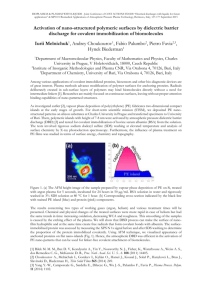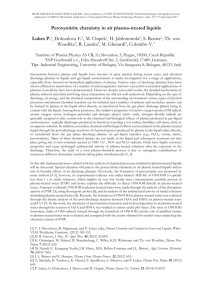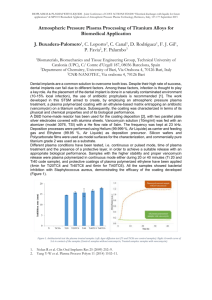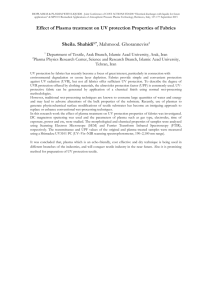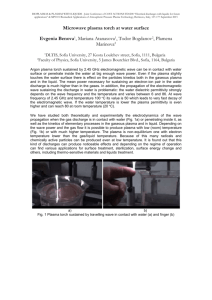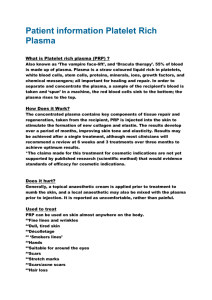Ilaria Trizio, Abstract-JOINT-COST-Bertinoro-13-17-September
advertisement
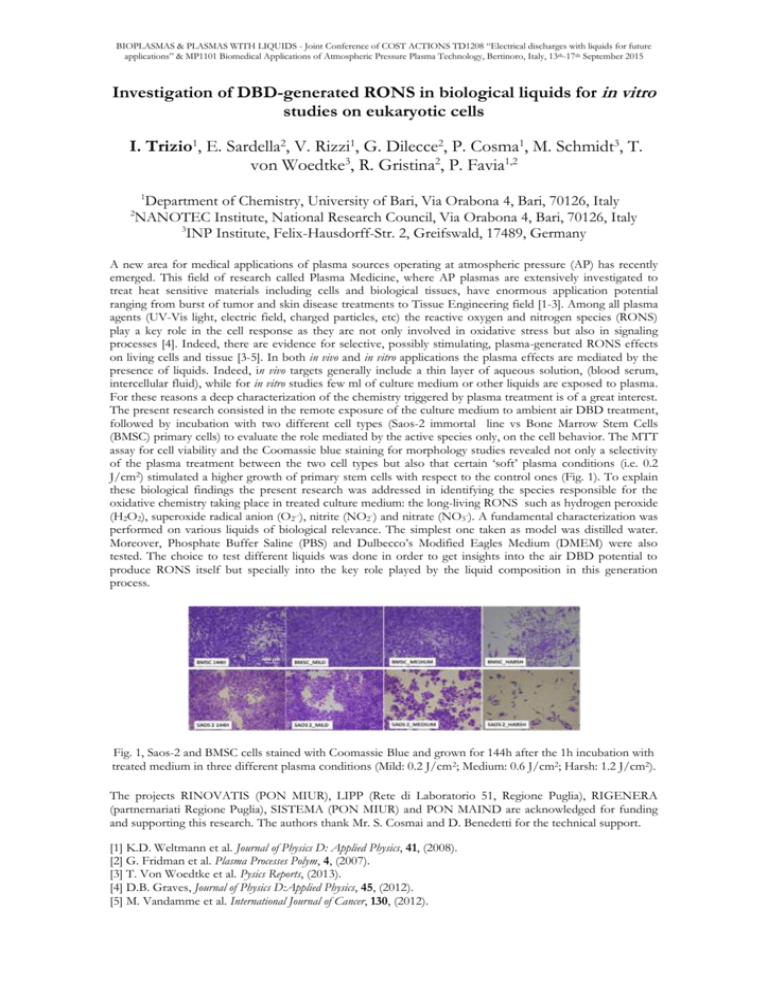
BIOPLASMAS & PLASMAS WITH LIQUIDS - Joint Conference of COST ACTIONS TD1208 “Electrical discharges with liquids for future applications” & MP1101 Biomedical Applications of Atmospheric Pressure Plasma Technology, Bertinoro, Italy, 13th-17th September 2015 Investigation of DBD-generated RONS in biological liquids for in vitro studies on eukaryotic cells I. Trizio1, E. Sardella2, V. Rizzi1, G. Dilecce2, P. Cosma1, M. Schmidt3, T. von Woedtke3, R. Gristina2, P. Favia1,2 1 Department of Chemistry, University of Bari, Via Orabona 4, Bari, 70126, Italy NANOTEC Institute, National Research Council, Via Orabona 4, Bari, 70126, Italy 3 INP Institute, Felix-Hausdorff-Str. 2, Greifswald, 17489, Germany 2 A new area for medical applications of plasma sources operating at atmospheric pressure (AP) has recently emerged. This field of research called Plasma Medicine, where AP plasmas are extensively investigated to treat heat sensitive materials including cells and biological tissues, have enormous application potential ranging from burst of tumor and skin disease treatments to Tissue Engineering field [1-3]. Among all plasma agents (UV-Vis light, electric field, charged particles, etc) the reactive oxygen and nitrogen species (RONS) play a key role in the cell response as they are not only involved in oxidative stress but also in signaling processes [4]. Indeed, there are evidence for selective, possibly stimulating, plasma-generated RONS effects on living cells and tissue [3-5]. In both in vivo and in vitro applications the plasma effects are mediated by the presence of liquids. Indeed, in vivo targets generally include a thin layer of aqueous solution, (blood serum, intercellular fluid), while for in vitro studies few ml of culture medium or other liquids are exposed to plasma. For these reasons a deep characterization of the chemistry triggered by plasma treatment is of a great interest. The present research consisted in the remote exposure of the culture medium to ambient air DBD treatment, followed by incubation with two different cell types (Saos-2 immortal line vs Bone Marrow Stem Cells (BMSC) primary cells) to evaluate the role mediated by the active species only, on the cell behavior. The MTT assay for cell viability and the Coomassie blue staining for morphology studies revealed not only a selectivity of the plasma treatment between the two cell types but also that certain ‘soft’ plasma conditions (i.e. 0.2 J/cm2) stimulated a higher growth of primary stem cells with respect to the control ones (Fig. 1). To explain these biological findings the present research was addressed in identifying the species responsible for the oxidative chemistry taking place in treated culture medium: the long-living RONS such as hydrogen peroxide (H2O2), superoxide radical anion (O2.-), nitrite (NO2-) and nitrate (NO3-). A fundamental characterization was performed on various liquids of biological relevance. The simplest one taken as model was distilled water. Moreover, Phosphate Buffer Saline (PBS) and Dulbecco’s Modified Eagles Medium (DMEM) were also tested. The choice to test different liquids was done in order to get insights into the air DBD potential to produce RONS itself but specially into the key role played by the liquid composition in this generation process. Fig. 1, Saos-2 and BMSC cells stained with Coomassie Blue and grown for 144h after the 1h incubation with treated medium in three different plasma conditions (Mild: 0.2 J/cm 2; Medium: 0.6 J/cm2; Harsh: 1.2 J/cm2). The projects RINOVATIS (PON MIUR), LIPP (Rete di Laboratorio 51, Regione Puglia), RIGENERA (partnernariati Regione Puglia), SISTEMA (PON MIUR) and PON MAIND are acknowledged for funding and supporting this research. The authors thank Mr. S. Cosmai and D. Benedetti for the technical support. [1] K.D. Weltmann et al. Journal of Physics D: Applied Physics, 41, (2008). [2] G. Fridman et al. Plasma Processes Polym, 4, (2007). [3] T. Von Woedtke et al. Pysics Reports, (2013). [4] D.B. Graves, Journal of Physics D:Applied Physics, 45, (2012). [5] M. Vandamme et al. International Journal of Cancer, 130, (2012). BIOPLASMAS & PLASMAS WITH LIQUIDS - Joint Conference of COST ACTIONS TD1208 “Electrical discharges with liquids for future applications” & MP1101 Biomedical Applications of Atmospheric Pressure Plasma Technology, Bertinoro, Italy, 13th-17th September 2015
